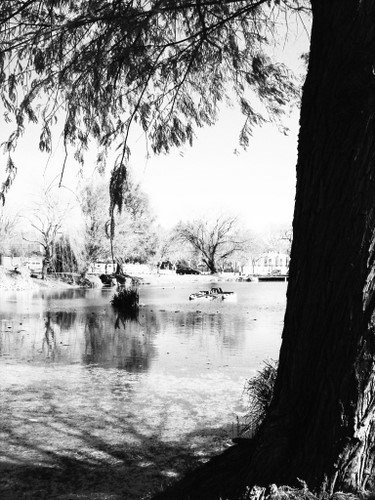 On the morning of 27th October 1964 a young teacher, Mr Robert Bekker, made a grisly discovery. On the western shore of Boksburg Lake, in a suitcase was a middle-aged woman’s
decapitated torso, covered in plastic, brown paper and a sheet. Although there were numerous stab wounds in her chest and back, a postmortem revealed that these had been inflicted after her death. The victim had first been battered and then had her throat cut. She had been in the water between 24 and 48 hours. Immediately a call went out to police stations in the region for the names and descriptions of any women recently reported missing. A number of replies were received, but none matched the description of the victim. Also, the victim’s fingerprints did not match any on record. A public appeal for information led to the anticipated crop of hoaxers as well as those genuinely eager to assist. Despite front-page headlines, country-wide publicity and numerous appeals by the police, the identity of the victim remained a complete mystery.
On the morning of 27th October 1964 a young teacher, Mr Robert Bekker, made a grisly discovery. On the western shore of Boksburg Lake, in a suitcase was a middle-aged woman’s
decapitated torso, covered in plastic, brown paper and a sheet. Although there were numerous stab wounds in her chest and back, a postmortem revealed that these had been inflicted after her death. The victim had first been battered and then had her throat cut. She had been in the water between 24 and 48 hours. Immediately a call went out to police stations in the region for the names and descriptions of any women recently reported missing. A number of replies were received, but none matched the description of the victim. Also, the victim’s fingerprints did not match any on record. A public appeal for information led to the anticipated crop of hoaxers as well as those genuinely eager to assist. Despite front-page headlines, country-wide publicity and numerous appeals by the police, the identity of the victim remained a complete mystery.
A second piece of the puzzle unfolded at Wemmer Pan, Johannesburg, on Saturday 7th November. In the middle of a yachting regatta a plastic bag floated to the surface, and when opened, proved to contain the Boksburg Lake victim’s dismembered legs! Immediately the area was cordoned off and police frogmen searched frantically, but unavailingly, for the vital missing
piece - the head!
Then, on the 17th December, two boys fishing at Zoo Lake in Johannesburg hooked a plastic bag containing a woman’s toothless head. It was in an advanced state of decomposition, making the features unrecognizable, and clearly had been in the water for some weeks.
Forensic pathologists and artists spent the next 24 hours putting together a set of drawings of the victim’s face. These were published on the 18th December and the police were confident that it would be merely a matter of time before the victim’s identity was established. In actual fact it took almost four years before a positive identification was made. This was in spite of the fact that the victim’s daughter, Catherine Cronje, gave the police the correct identification of the victim (Mrs Catherine Burch) and was certain that the victim was her mother. However, her family and fiancé talked her out of visiting the mortuary.
Almost a year later an inquest was held in Boksburg, where the verdict was given as ’death unascertained’. The remains were buried in a pauper’s grave.
In August 1968, Catherine (now Mrs van Coppenhagen) decided that she would wait no longer and told a certain Police Captain, James Beeslaar, of her fears and convictions. He reopened the case and, in particular, started searching for the dead woman’s husband, Ronald Burch, who had not been seen for four years
Burch, who had matriculated at Boksburg High School, was a ladies man and had been married and divorced three times before he met Catherine Cronje, whom he married shortly after her divorce in 1962. After Catherine’s disappearance, Burch resigned from his job, told his wife’s employer that she had taken ill suddenly and would not be returning to work, collected the salary owing to her and then vanished. The police later established that early in 1965 Burch had moved to 65 Berea Road,
Bertrams in Johannesburg, where he lived with his widowed mother for some months. On 27th November 1968, the police again interviewed Burch’s mother (the first time being on 4th October). She initially denied that her son was staying with her, but eventually broke down and admitted that he was in a room in the back yard and gave the police a key.
When the police unlocked the door, they found Ronald Burch standing in the middle of the room wearing home-made bracelets made from tins to which he had soldered electrical wires that were plugged into a wall socket. As the door opened, Burch flicked the switch, electrocuting himself. Moments later he was dead. It took another 10 days for the final strand in this tragedy to be unraveled. Proof positive was needed to link the dead man and woman together. This proof came from a letter, written by Catherine Burch, which Catherine van Coppenhagen handed to the police. An expert in the police fingerprinting bureau found a fingerprint on the letter that matched the one on the corpse. The body in the lake had finally been identified.
In May 1969 the inquest on Catherine Burch was reopened. Although the police had solved this bizarre murder, the actual cause of death could still not be established and was recorded once again as ’unascertained’.
The above text was kindly supplied by the Boksburg Historical Assosiation http://www.geocities.com/boksburghistorical/
The coordinates supplied are to the place where we think
the incident probably took place next to the dam.
A photo must be provided with a visit.